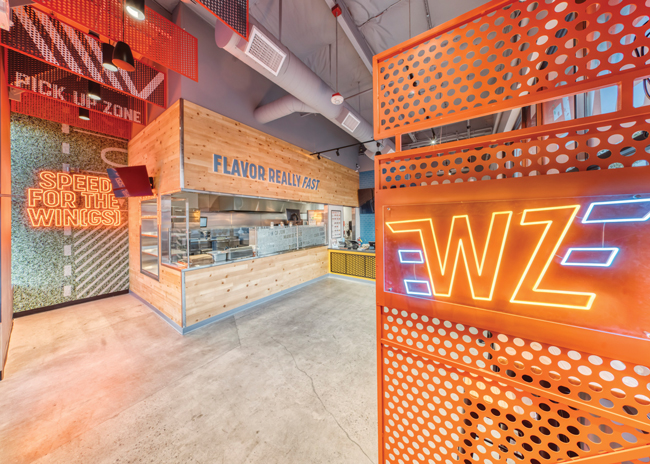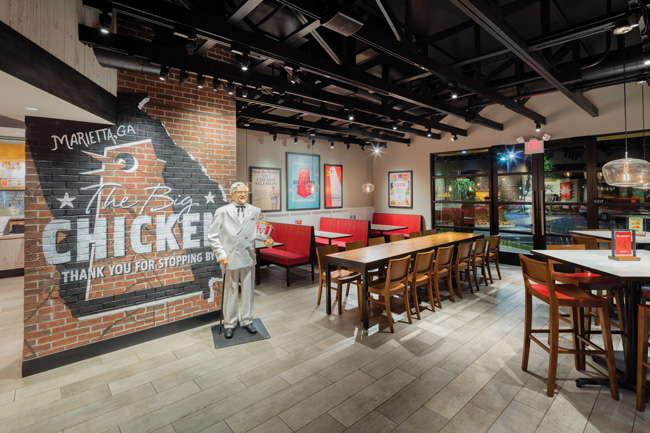Paris Baguette is not new to the United States. The concept, which is owned by South Korean company SPC Group, has been in the states for more than 15 years. In that time, it’s grown to about 120 locations scattered from coast to coast. That’s respectable. But the chain’s new growth projections show the company is aiming to become much more.
“Our goal is to get to 1,000 cafes in the U.S. by 2030. I think we will get to [that number] with some of the growth we are seeing and the number of franchise agreements we have signed,” says Pete Bell, Paris Baguette’s chief marketing officer.
That sort of growth would take Paris Baguette from a successful small-time player to a widely recognized brand, in the realm of companies like Firehouse Subs and Zaxby’s.
Every concept wants to grow, of course, but why does Paris Baguette think it can add nearly 900 restaurants in seven years after opening just over 100 the previous 15?
The answer lies in the niche Paris Baguette is pursuing and the work it’s put into filling that space.
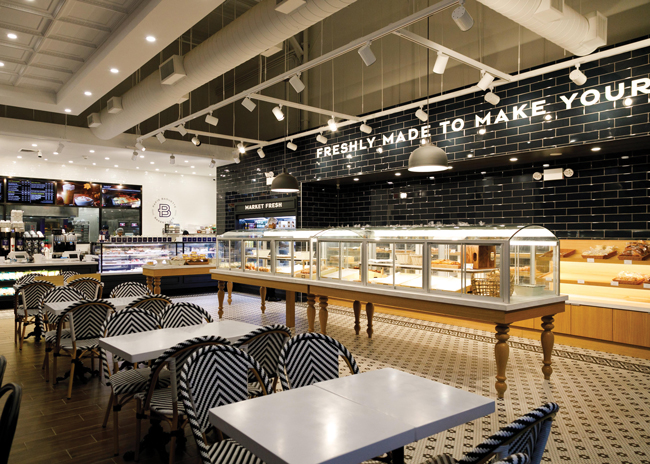 The chain switches from penny tile to wood-style tiles to create the dining area. Black and white bistro-style chairs give the space a hip feel. Images courtesy of Paris Baguette
The chain switches from penny tile to wood-style tiles to create the dining area. Black and white bistro-style chairs give the space a hip feel. Images courtesy of Paris Baguette
Bakery-Cafe
A look at Paris Baguette’s offerings, says Bell, shows that the concept is a true bakery-cafe. The menu is filled with freshly made breads, cakes, pastries, tarts, croissants and cookies. Guests can grab a brewed coffee or espresso drink while picking up a breakfast pastry, or enjoy a sandwich or salad as dine-in customers.
The concept sounds familiar enough, but it fills a space that the chain’s competitors have abandoned, Bell contends. “When you look at the bigger ones, the Corner Bakeries and the Paneras, they’ve really become more of an eatery than a cafe. If you think about Panera as an example, they moved into selling pastas at one point. Then they tried to sell pizzas. When you walk into a Panera today there is less of an emphasis on the baked goods, the pastries or the breads,” he says.
Paris Baguette, on the other hand, has and will keep baked goods as the core of the restaurant’s menu and identity. This niche is about more than a laser-focus on baking, Bell stresses. Bakery-cafes can be cornerstones of their communities, places where people come to enjoy some quiet time with a coffee and a muffin, gather together for meals, or grab a fresh loaf of bread or dessert for a special occasion.
“We don’t view ourselves as operating in a community. We view ourselves as being part of a community,” says Bell. “We want to know our regulars by name and what their favorite items are. We have also created a neighborhood cafe that delivers an emotional connection to those people in the community,” Bell says.
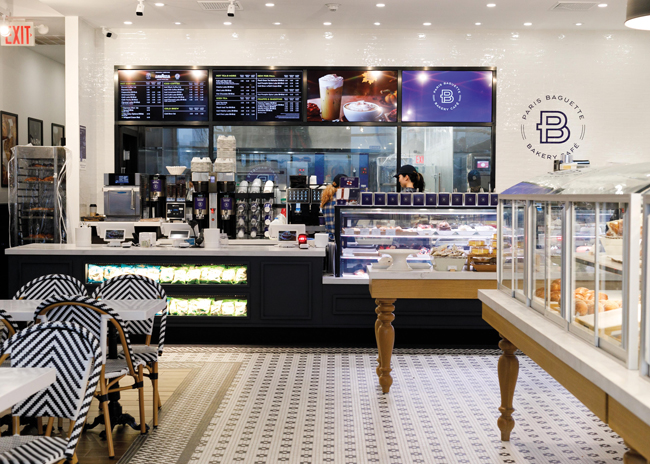 Penny tile adds to the French bistro feel of the new design.
Penny tile adds to the French bistro feel of the new design.
Brand DNA Work
Identifying an opening in the bakery-cafe space was just the first step in Paris Baguette’s growth plan. The chain’s leadership, which largely turned over in 2018 and 2019, has spent the last several years developing the infrastructure for growth.
On the most concrete level, the company invested in tools like a new POS system and analytics platform to help it better understand its business. These tools help the chain decipher ordering patterns, the success of seasonal offerings and how guests use the restaurant. The chain has also staffed up its franchise support team to support the many new partners it plans to add in the next few years.
Beyond these tangible steps, the chain’s leadership addressed problems involving Paris Baguette’s identity and brand. The company was not well defined in this country, says Bell. “There was no brand DNA in the U.S. You could bounce around from cafe to cafe and there wasn’t really consistency in what you would see from a product standpoint, a messaging standpoint or a marketing standpoint.”
To address this issue, the chain hired Push, a branding/marketing agency, to help define and refine the heart of the Paris Baguette brand. It was through this work that the chain honed in on the bakery-cafe space as its best opportunity for growth, says Bell.
Defining the brand and this value proposition took plenty of work from Paris Baguette and Push. There were questions and exercises with leadership that focused on what the concept offers and what makes it stand out. The team also conducted 15 focus groups of bakery-cafe customers from across the U.S. Due to the pandemic, these were all held over Zoom, Bell notes.
While that was a new experience for Paris Baguette’s leaders, “it allowed us to get out of our operating regions and go across the country. Not only do we want to hear from people who know our brand and use it, but people who use other bakery-cafes. We want to know what is important to them in a cafe and in the overall experience.”
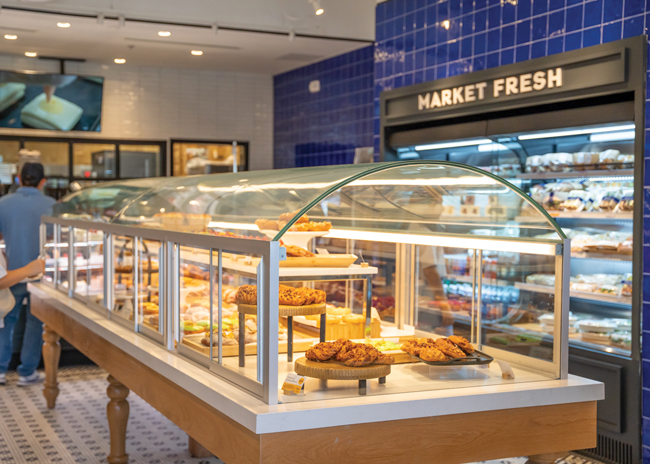 With a domed top and detailed legs, this custom-made case is meant to feel more like a piece of furniture than a food display.
With a domed top and detailed legs, this custom-made case is meant to feel more like a piece of furniture than a food display.
In addition to focus groups and exercises, Paris Baguette conducted studies in three large markets to see how people use bakery-cafes. The company hired people to go out into the field to complete a particular task as a customer and then report back on their experiences. Some of these were done at Paris Baguette, others at competing concepts.
Through this work, the chain determined what aspects of the brand to highlight. This included leaning into their niche as well as showcasing other aspects of the bakery-cafe experience, such as the skill of its bakers and cake decorators and the value of a community-focused restaurant.
Paris Baguette then put what it had learned to work. It developed strategies for marketing that includes higher-quality food photography, commercials on streaming television and videos that showcase the work the concept’s bakers do every day.
Then there was the design.
Push’s work included the development of a concept design, complete with renderings that highlight the core and strengths of the brand. Paris Baguette then partnered with Zebra, an architecture, design and branding firm out of Scottsdale, Ariz., to bring this concept design into the real world.
While elements of this new design have been built into multiple restaurants over the past year, the first locations with the new look opened last fall in Livingston, N.J., and Winter Park, Fla.
The Zone as Concept
The new design for Paris Baguette is meant to create a relaxed atmosphere while at the same time having a touch of cool and style. This is achieved using black and white finishes that are often elevated, along with the chain’s signature blue.
The restaurant, Bell says, is designed as a place where people can visit “any time of day for any reason. It could be a work lunch, it could be a date, it could be bringing the kids in after a soccer game. We were looking for that experience that you don’t find in a lot of communities anymore.”
To capitalize on its research and development, they chose to create three distinct zones within the restaurant: Masters at Work, Bread and Butter, and Warm Welcome.
Importantly, individual zones can be broken up into smaller pieces that are placed in different spots in the store. What makes a zone, then, is the message and feel it conveys.
The Masters at Work zone, for example, highlights the work of the operation’s kitchen team. Since the chain makes all food in-house each day (with no commissary help), each Paris Baguette has a team of skilled bakers and cake decorators. Their talents are highlighted in the new design.
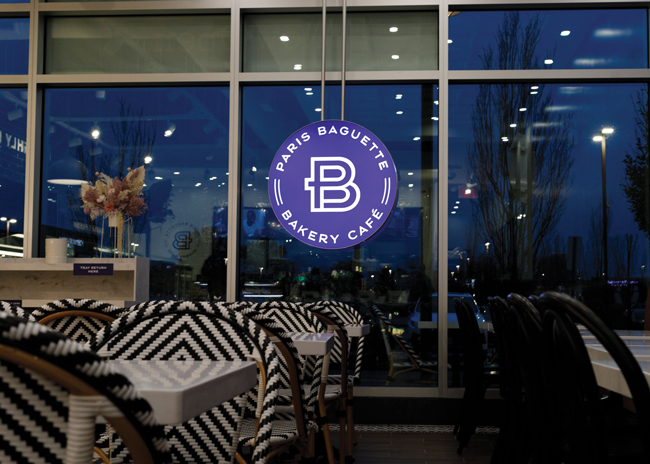 The lit pendant is one of the signatures of Paris Baguette’s new prototype. It is positioned to not block the view of the baked goods from the sidewalk.As guests enter, they encounter the cake decorators, who work behind a set of windows. Guests or even just people passing by can watch as the decorators make whipped cream and frosting, slice fruits and decorate the cakes. This idea also plays out where the bakery operation itself is located (that varies based on footprint). In the new design, guests can get a peek into this operation thanks to a set of windows behind the counter. These windows aren’t just cutouts. To contain airborne flour, actual glass panes separate the bakery operation from the customers.
The lit pendant is one of the signatures of Paris Baguette’s new prototype. It is positioned to not block the view of the baked goods from the sidewalk.As guests enter, they encounter the cake decorators, who work behind a set of windows. Guests or even just people passing by can watch as the decorators make whipped cream and frosting, slice fruits and decorate the cakes. This idea also plays out where the bakery operation itself is located (that varies based on footprint). In the new design, guests can get a peek into this operation thanks to a set of windows behind the counter. These windows aren’t just cutouts. To contain airborne flour, actual glass panes separate the bakery operation from the customers.
“You see that we are making products every day on-premises,” says Bell. “You see the people who are doing it. That brings that credibility and reinforces
that we offer a high-quality product. Most places when you walk in, you don’t see that. When you walk into a Paris Baguette you see it, you smell it and you can taste it.”
The second zone, Bread and Butter, showcases the final products. This area is given an elevated feel thanks to dark subway-tiled walls and a patterned penny tile floor in black and white. Guests can select their own baked goods from wooden shelves sitting against the wall, while whole and individual slices of cakes are stored in a bakery display case next to the POS Station.
The centerpiece of Bread and Butter is a large display case sitting in the middle of the restaurant holding loaves of bread, croissants and other baked goods. The company invested extra in this piece, which features a domed top and legs with extra detailing.
“We really wanted it to look more like a piece of furniture,” Bell says. “We are trying to [evoke] nostalgia. We didn’t just want a big wooden box sitting there with a glass dome on it. We wanted it to look more like furniture.”
The final zone is Warm Welcome. This consists of the POS station and the dining area. This section is straightforward, and the warm welcome lies largely in employee training.
The dining area has much more of the tangible comfort Paris Baguette wants to offer. Instead of penny tile, this area has been outfitted with wood-style ceramic tile. This gives the section a warmer feel while also creating a boundary that separates dine-in guests from those choosing their items in the Bread and Butter zone.
The space also features comfortable-but-cool black and white chairs that are reminiscent of a French bistro, Bells says, while a banquette against the wall is upholstered in brown leather, giving the space a touch of luxury. Together, he notes, these elements create a space where people are free to eat and run, but also linger over a cup of coffee and a treat.
In addition to these three zones, the new design includes elements that emphasize the brand’s strengths and differentiators. Each location has a mural of the local area with local landmarks that drives home its connection to the community as well as a wall decal that recounts Paris Baguette’s community connection and bakery experience. The Bread and Butter area, meanwhile, features a large decal proclaiming its food is “Freshly made to make your day.”
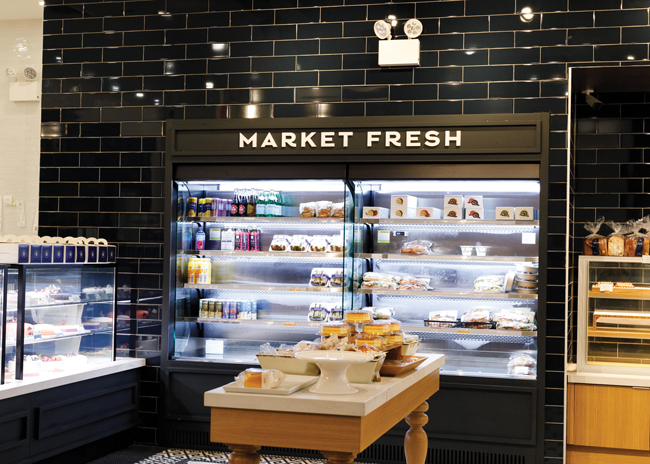 The chain’s grab-and-go offerings are marketed in coolers, display cases, shelves and tables.
The chain’s grab-and-go offerings are marketed in coolers, display cases, shelves and tables.
Geared up for Growth
With Paris Baguette’s design set and corporate operations primed, the chain is now moving into this period where it expects rapid growth. The types of markets Paris Baguette targets include urban and suburban residential areas as well as central business districts. It’s also exploring nontraditional locations, with the first Paris Baguette in a university setting opening soon and transportation hubs like airports and train stations on the company’s radar.
Geographically, the chain isn’t targeting one specific region. Instead, it will open wherever it finds the right partners. For Paris Baguette, that means people with enough operational experience to run a bakery.
“This isn’t like a fast-food chain where you are putting something into a [fast-cooking oven], pushing a button and you’ve cooked it. We need someone who has the operational skill and is willing to invest in the time and the training for themselves and their team,” Bell says.
Competition for quality franchise partners is, of course, always stiff. With Paris Baguette’s investments in its business, along with its new design, the company hopes its value proposition as it goes to market can take it to 1,000 locations in the U.S. by the end of the decade.
“We’ve got a great development team that’s out talking with prospective buyers to sign up, selling our brand with the new brand DNA, the results we are seeing in our sales and how we market the brand today. When you create a neighborhood cafe like this it gives us a lot of different talking points. It’s not just a product we can talk to, but a lifestyle and connections with neighborhoods.”
Project Team
- Project lead: Zebra and Paris Baguette America
- Architect and interior design: Zebra
Snapshot
- Headquarters: Moonachie, N.J.
- Concept: Bakery-cafe
- Unit count: 120
- Average check: $17
- Location of new prototype: Winter Park, Fla.
- Opened: October 2022
- Size: 2,600 square feet
- Design highlights: The restaurant is designed with three zones: Masters at Work, which showcases the skill of the concept’s bakers and cake decorators; Bread and Butter, which displays the operation’s baked goods; and Warm Welcome, which welcomes guests who want to linger over a cup of coffee and baked treat or just grab a loaf of bread or dessert and leave.
- Build-out time: 18 weeks

